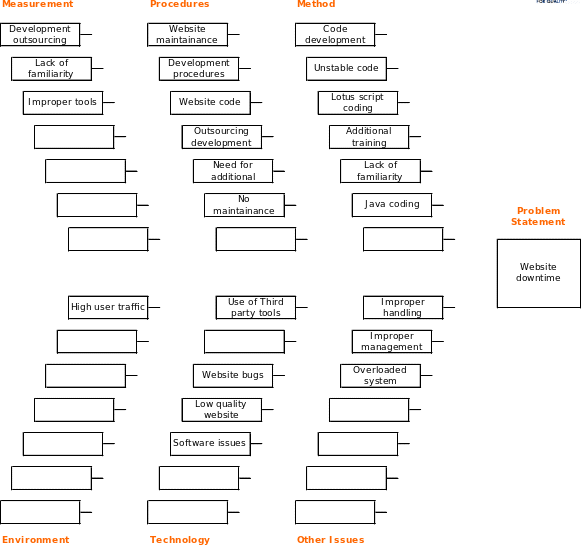Introduction
Organizations in the current age have adopted technology to enhance their visibility and to link with their customers. Websites can be used by organizations to provide potential clients with insight into the firm, which can facilitate better business. An issue that has happened at the workplace a significant number of times is website downtime. This is an aspect that can be explained as the number of times a site is inaccessible to clients or consumers. For organizations that rely on websites to sell their product, experiencing downtime can result in a loss of credibility (Chivinge et al., 2021). This is because clients prefer firms that are consistent in providing services.
The issue has affected the company as the number of clients has been declining every year. Understanding the root cause of the issue can help the organization enhance its service delivery. Website downtime can be analyzed using the categories of methods, procedures, measurement, environment, and technology. The problem can be caused by the presence of unstable code, lack of familiarity with the website, and overloading. The organization is dependent on the internet site to market its products and to reach clients. This indicates that solving the issue will benefit the firm in a significant way.
Symptoms
Frequent website crashes prompted the investigation on what was the root cause of the issue. A prior analysis had indicated that the website was down during peak hours, which caused a loss of clients. The initial diagnosis was given as service failures and mistakes in the coding process. However, no follow-up was conducted to investigate the underlying reasons for the identified issues. Another aspect was that the website was slow to load, which can be a result of poor infrastructure. The need to improve the functionality of the website necessitated understanding the root cause of the problem.
Table 1: Five whys for website downtime

Based on the root cause analysis, the identified root cause was the lack of proper maintenance for the website. The countermeasure that was developed was to conduct training for employees to ensure they can handle future activities. The website requires constant care because of the high traffic it handles during peak hours (Chivinge et al., 2021). The firm needs to outsource development to entities that can pass on the knowledge to the employees. This will prevent the occurrence of the problem in the future and ensure the company gains its client back.
Analysis
The fishbone diagram provided insight into the cause of the problem based on various categories. On the aspect of the method, the model indicates that the coding process used and the lack of familiarity by employees are significant issues. The technology used was also an essential part of understanding the root cause. The use of third-party tools has resulted in a lack of familiarity because the employees do not have a background in some of the tools adopted. The company operates in a high-user traffic environment, which results in high instances of website downtime. The infrastructure adopted by the firm does not meet the traffic that is received on the website daily. The identified countermeasures require the organization to invest in employee training and infrastructure changes. This will ensure that the problem is not witnessed in the future.
Process
The problem that was identified was website downtime and the first step was to conduct a root cause analysis using the five whys model. The main intention was to answer the question of why the organization experienced website downtime. After brainstorming, coding, outsourcing development, lack of familiarity, overloading, and lack of maintenance were viewed as the main causes of the problem. Based on the five whys model, poor maintenance was the root cause of website downtime. The organization needs to invest in training the employees to handle the monitoring activities because external entities may enhance the problem. The fishbone diagram also created a better understanding of the challenge using various categories. The step that followed was to identify causes in each of the individual aspects. This ensured that the problem was analyzed exhaustively and the root causes were identified.
Conclusion
In summary, the process of understanding the root cause of a problem affecting an organization was insightful. The procedure expanded the knowledge that problems can be caused by a combination of issues. The root cause may be difficult to identify without using certain procedures that ensure all aspects are taken into account. The fishbone diagram can help in mapping out the categories that assist in defining the challenge.
Reference
Chivinge, J. R., Dube, S., & Ndayizigamiye, P. (2021). Strategies used to address challenges encountered during website development in South Africa. South African Journal of Information Management, 23(1), 1-9. Web.